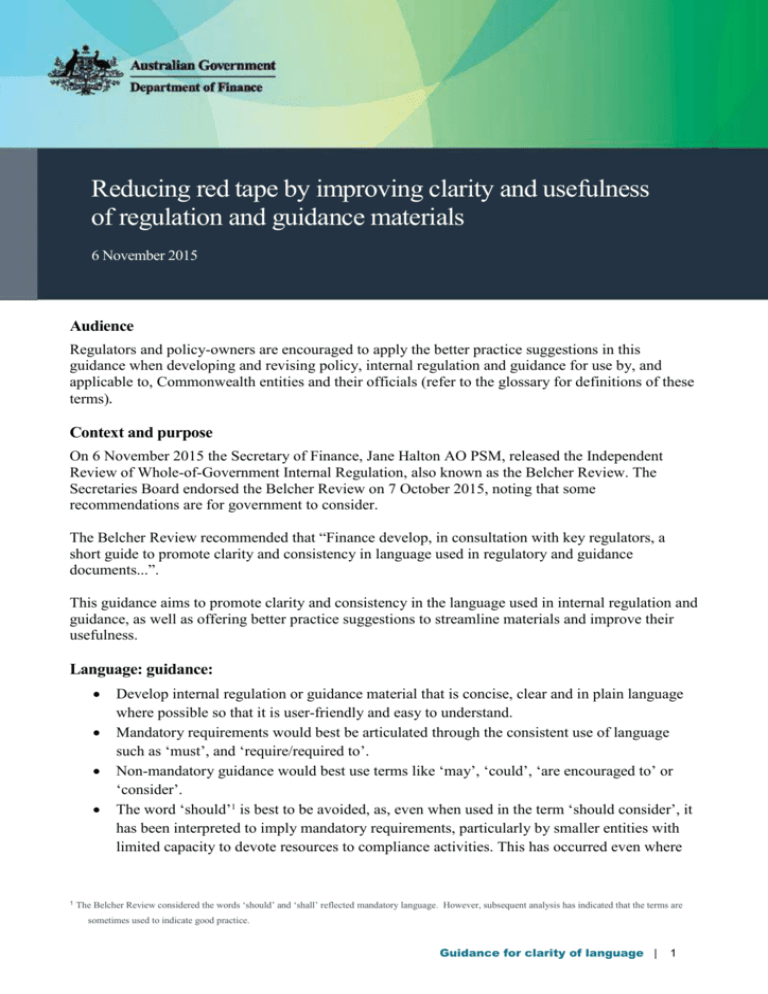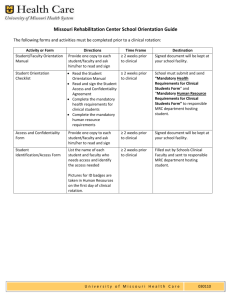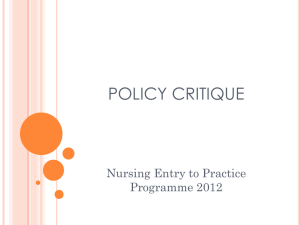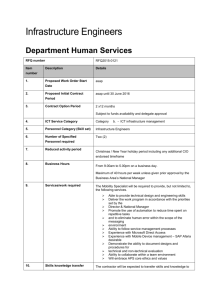Reducing red tape by improving clarity and usefulness of regulation
advertisement

Reducing red tape by improving clarity and usefulness of regulation and guidance materials 6 November 2015 Audience Regulators and policy-owners are encouraged to apply the better practice suggestions in this guidance when developing and revising policy, internal regulation and guidance for use by, and applicable to, Commonwealth entities and their officials (refer to the glossary for definitions of these terms). Context and purpose On 6 November 2015 the Secretary of Finance, Jane Halton AO PSM, released the Independent Review of Whole-of-Government Internal Regulation, also known as the Belcher Review. The Secretaries Board endorsed the Belcher Review on 7 October 2015, noting that some recommendations are for government to consider. The Belcher Review recommended that “Finance develop, in consultation with key regulators, a short guide to promote clarity and consistency in language used in regulatory and guidance documents...”. This guidance aims to promote clarity and consistency in the language used in internal regulation and guidance, as well as offering better practice suggestions to streamline materials and improve their usefulness. Language: guidance: 1 Develop internal regulation or guidance material that is concise, clear and in plain language where possible so that it is user-friendly and easy to understand. Mandatory requirements would best be articulated through the consistent use of language such as ‘must’, and ‘require/required to’. Non-mandatory guidance would best use terms like ‘may’, ‘could’, ‘are encouraged to’ or ‘consider’. The word ‘should’1 is best to be avoided, as, even when used in the term ‘should consider’, it has been interpreted to imply mandatory requirements, particularly by smaller entities with limited capacity to devote resources to compliance activities. This has occurred even where The Belcher Review considered the words ‘should’ and ‘shall’ reflected mandatory language. However, subsequent analysis has indicated that the terms are sometimes used to indicate good practice. Guidance for clarity of language | 1 the use of the term has been defined in the document as meaning good practice and not mandatory. Similarly, while ‘shall’ was traditionally used in legal drafting to refer to an obligation, it is also best avoided as it can be confusing in different contexts (for example, it can sometimes mean ‘will’, ‘should’ or ‘may’) and is not plain language. Referring to mandatory requirements: guidance: Internal regulation and guidance information clearly state the authority for the mandatory requirements. A brief explanation of the reason behind the request for action can also assist agencies in better understanding the clear connection between the regulation design and desired policy outcomes. Clearly cite (preferably link) and not paraphrase all references to mandatory requirements imposed by other documents or legislation. Identify clearly in one section and early in the document all mandatory requirements; however, if that is not feasible, the practice of highlighting in bold every mandatory reference, for example every ‘must’ or ‘required to’, can be an effective way of focussing on the mandatory elements. It may also be useful to include a box at the beginning of the document stating how the words such as ‘must’, ‘may’, ‘could’, or ‘consider’ are to be interpreted in the document. Where guidance is in the form of a better practice guide, it is made clear that these are non-mandatory. It is important to resist the idea that mandating guidance is helpful to entities and in their best interest. It rarely is. Conversely, where authority exists, documents can be mislabelled as guidance. Government policy which sets out mandatory requirements for non-corporate Commonwealth entities needs to be clearly identified. Improving accessibility and usefulness: good practice suggestions: Guidance materials, including templates, are digital by design, to maximise the opportunities for web publication, disability accessibility, and information interoperability. Regulation and guidance materials are developed in consultation with stakeholders, to test clarity and usefulness, and ensure templates and reports meet internal as well as external compliance and reporting requirements (in accordance with the Principles for Internal Regulation – refer to the glossary for further information). Guidance material supports differing approaches depending on the size and complexity of the entity, and the need for exercising judgements based on an assessment of risk for both the entity, and the government as a whole. Compliance burden on entities in interpreting mandatory requirements can be reduced by including case studies, worked samples and /or optional, adaptable templates. The different needs of particular audiences are a consideration. This might include having different documents, or using different media (e.g. web content), to target specific audiences or address more general needs. For example: Guidance for clarity of language | 2 o one core document for accountable authorities and a more detailed document to assist staff responsible for implementing or complying with internal regulation; or o on the basis of security classification, one document for classified material and another document for related, but unclassified material, that would be better disseminated to a wider audience. Guidance materials are designed to be as short as possible, with additional material such as worked samples and templates, questions and answers, or targeted fact sheets for different audiences, available as attachments or additional weblinks. Background Regulators issue information to assist entities to comply with mandatory requirements contained in legislation, subordinate legislation, such as regulations and rules, or government policy issued by the Prime Minister, Cabinet or responsible ministers. Policy owners can issue non-mandatory, or better practice, guidance. The Belcher Review found that there can be confusion within regulators and users about what internal regulation is mandatory and what guidance is to be applied if it makes good sense. The main driver of the confusion is that mandatory requirements and non-mandatory guidance has often been expressed in terms that lack clarity, creating confusion and unnecessary internal red tape. Glossary Internal regulation: Requirements that are mandatory for all or most entities, or guidance, practice or procedure that is treated as such. Regulations that apply beyond the public sector, for example taxation and privacy legislation, are beyond the scope of this guidance. Policy owner: A Commonwealth entity responsible for issuing non-mandatory guidance. Principles for Internal Regulation: Secretaries Board has agreed to the Belcher Review’s recommendation that regulators use the following Principles for Internal Regulation to guide the development and assessment of internal regulation. These are: the minimum needed to achieve policy (or entity) outcomes; proportional to the risks to be managed and supportive of a risk-based approach; coherent across government and not duplicative; designed in consultation with stakeholders for clarity and simplicity in application; and reviewed periodically to test their relevance and impact. Regulator: A Commonwealth entity responsible for imposing internal regulation. Further resources Further information and guidance related to the Belcher Review and resource management is available from finance.gov.au/resource-management/. Key tools on the site include: The Belcher Review – links to the Report and related documents; The Principles for Internal Regulation – links to the documents detailing the Principles; PGPA legislation and rules – links to the PGPA Act, rules and instruments; Consolidated guidance – a complete index of all resource management guidance; Glossary – common resource management terms; and Support tools – introductory resources such as training and eLearning modules, and information on the Public Management Reform Agenda. Guidance for clarity of language | 3





